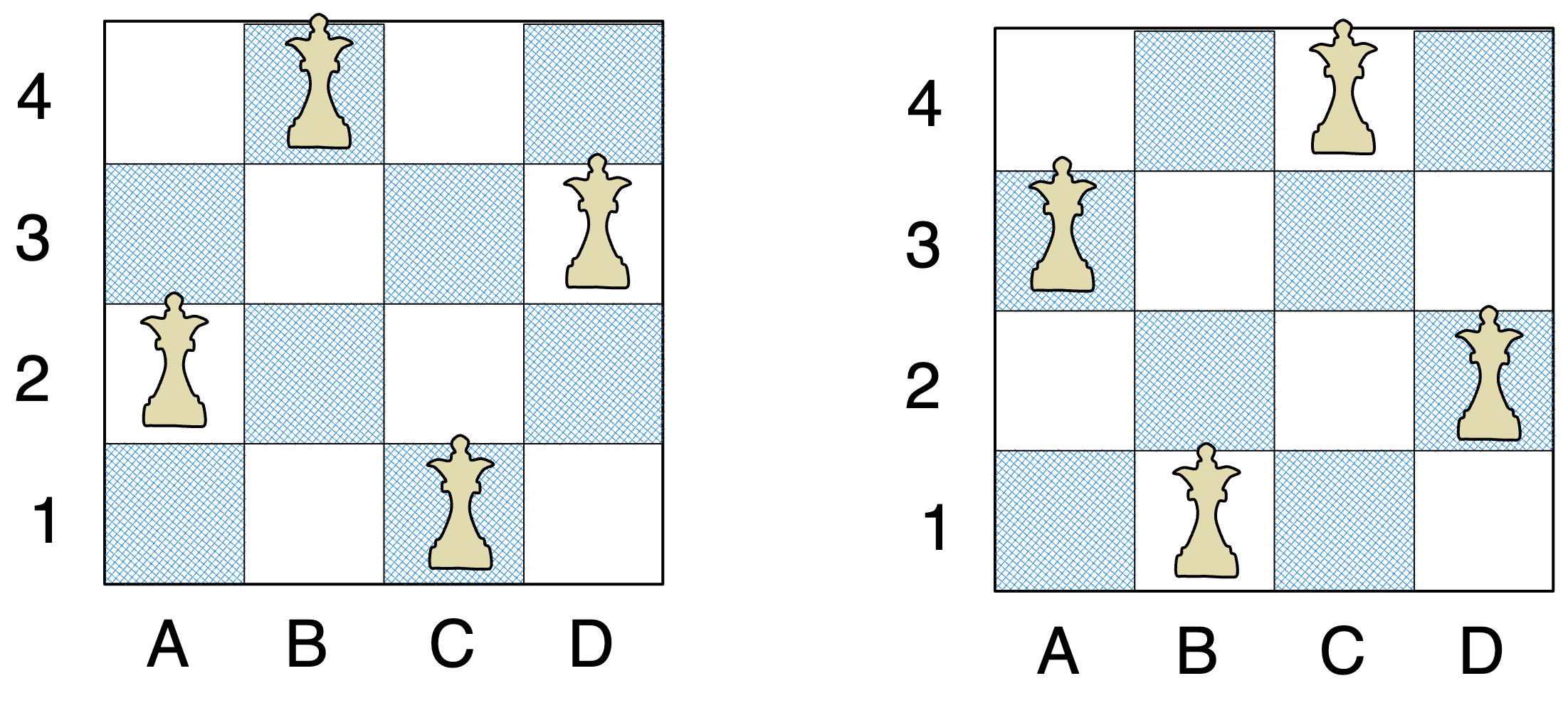N-Queens 2 - Count number of distinct solutions
HardUpdated: Aug 2, 2025
Practice on:
Problem
The n-queens puzzle is the problem of placing n queens on an n x n chessboard such that no two queens attack each other.
Given an integer n, return the number of distinct solutions to the n-queens puzzle.
Examples
Example 1:

Input: n = 4
Output: 2
Explanation: There are two distinct solutions to the 4-queens puzzle as shown.
Example 2:
Input: n = 1
Output: 1
Solution
We have already seen [N-Queens](n-queens). We can use backtracking similar to that, and may be this problem is bit easier.
Method 1 - Backtracking Using O(N^2) Space Matrix
This is similar to the problem we had solved with O(n^2) matrix in [N-Queens](n-queens). But in dfs, we will not pass a list and also return a count instead of adding solution to list.
Code
Java
public int totalNQueens(int n) {
char[][] board = new char[n][n];
for (char[] row: board) {
Arrays.fill(row, '.');
}
return dfs(board, 0);
}
private int dfs(char[][] board, int colIndex) {
if (colIndex == board.length) {
return 1;
}
int count = 0;
for (int i = 0; i<board.length; i++) {
if (isSafe(board, i, colIndex)) {
board[i][colIndex] = 'Q';
count += dfs(board, colIndex + 1);
board[i][colIndex] = '.';
}
}
return count;
}
private boolean isSafe(char[][] board, int x, int y) {
for (int i = 0; i<board.length; i++) {
for (int j = 0; j<y; j++) {
if (board[i][j] == 'Q' && (x + j == y + i || x + y == i + j || x == i)) {
return false;
}
}
}
return true;
}
Method 2 - Backtracking Using O(N) Space Row
Again this is similar to Backtracking Using O(N) Space Row in [N-Queens](n-queens).
Code
Java
public int totalNQueens(int n) {
return dfs(0, new int[n]);
}
public int dfs(int cur, int[] row) {
if (cur == row.length) {
return 1;
}
int count = 0;
for (int i = 0; i < row.length; i++) {
boolean ok = true;
row[cur] = i;
for (int j = 0; j < cur; j++) {
if (row[cur] == row[j] || row[cur] - row[j] == cur - j || row[cur] - row[j] == j - cur) {
ok = false;
break;
}
}
if (ok) {
count += dfs(cur + 1, row);
}
}
return count;
}
Complexity
- ⏰ Time complexity:
O(N! * N) - 🧺 Space complexity:
O(N^2)
Method 3 - Backtracking Using Sets for Row and Diagonals
Code
Java
public int totalNQueens(int n) {
int[] res = new int[1];
helper(res,n,0);
return res[0];
}
public void helper(int[] res, int n, int row){
if(row==n){
res[0]++;
}
else{
for(int i=0; i<n; i++){
if(col.contains(i) || diag1.contains(i+row) || diag2.contains(row-i)) continue;
else{
col.add(i);
diag1.add(i+row);
diag2.add(row-i);
helper(res,n,row+1);
col.remove(i);
diag1.remove(i+row);
diag2.remove(row-i);
}
}
}
}
Method 4 - Backtracking Using Boolean Arrays for Col and Diagonals
Code
Java
public class Solution {
int count = 0;
public int totalNQueens(int n) {
boolean[] cols = new boolean[n]; // columns |
boolean[] d1 = new boolean[2 * n]; // diagonals \
boolean[] d2 = new boolean[2 * n]; // diagonals /
backtracking(0, cols, d1, d2, n);
return count;
}
public void backtracking(int row, boolean[] cols, boolean[] d1, boolean []d2, int n) {
if(row == n) count++;
for(int col = 0; col < n; col++) {
int id1 = col - row + n;
int id2 = col + row;
if(cols[col] || d1[id1] || d2[id2]) continue;
cols[col] = true; d1[id1] = true; d2[id2] = true;
backtracking(row + 1, cols, d1, d2, n);
cols[col] = false; d1[id1] = false; d2[id2] = false;
}
}
}